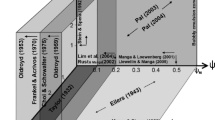Abstract
The transient-network model for concentrated dispersions, described in a previous paper, is used to describe the rheological behaviour of dispersions of glyceryl tristearate crystals in paraffin oil. The model prediction of the storage modulus of this system is compared with corresponding expressions given in literature. Model calculations are carried out to fit the linear viscoelastic behaviour of the system as well as its stress response in large amplitude shear experiments. Information is thus obtained about the stiffness and strength of the interparticle bonds, and the chance of them breaking in a state of rest or as the result of flow. It is concluded that the probability of interparticle bond fracture strongly depends on the measure of bond stretching. The general findings link up with the Lennard-Jones potential which is assumed to describe the potential energy of the bonds between the particles. Accurate measurements of the temperature dependence of the dynamic moduli by making use of a torsion resonator lead to the conclusion that the energy dissipation at a high frequency originates mainly from the flow of liquid around the particles.
Similar content being viewed by others
References
Van den Tempel M (1961) J Coll Sci 16:281
Van den Tempel M (1979) J Coll Interf Sci 71:18
Nederveen CJ (1963) J Coll Sci 18:276
Papenhuijzen JMP (1972) Rheol Acta 11:73
De Bruijne DW, Prichard NJ, Papenhuijzen JMP (1974) Rheol Acta 13:418
Struik LCE (1980) Rheol Acta 19:111
Takano M (1963) Bull of the Chem Soc of Japan 36:1418
Strivens TA (1983) Coll & Polym Sci 261:74
Zosel A (1982) Rheol Acta 21:72
Kemblowski Z, Petera J (1979) Rheol Acta 18:702
Kemblowski Z, Petera J (1980) Rheol Acta 19:529
Cheng DCH (1980) Chem Ind L 10:403
Tanaka H, Whilt JL (1980) J Non-Newtonian Fluid Mech 7:333
Jarzebski GJ (1981) Rheol Acta 20:280
Firth BA, Hunter RJ (1976) J Coll Interf Sci 57:266
Van de Ven TGM, Hunter RJ (1977) Rheol Acta 16:534
Hunter RJ (1982) Adv Coll Interf Sci 17:197
Ekdawi N, Hunter RJ (1983) J Coll Interf Sci 94:355
Van den Tempel M (1980) (ed) Walters K, Rheometry — Industrial applications, Wiley, New York
Kamphuis H, Jongschaap RJJ, Mijnlieff PF (1984) Rheol Acta 23:329
Lodge AS (1968) Rheol Acta 7:379
Firth BA (1980) Rheol Acta 19:716
Cox RG, Brenner H (1967) Chem Eng Sci 22:1753
Heath D, Tadros TF (1983) Farad Discuss Chem Soc 76
Blom C, Mellema J (1984) Rheol Acta 23:98
Author information
Authors and Affiliations
Rights and permissions
About this article
Cite this article
Kamphuis, H., Jongschaap, R.J.J. The rheological behaviour of suspensions of fat particles in oil interpreted in terms of a transient-network model. Colloid & Polymer Sci 263, 1008–1024 (1985). https://doi.org/10.1007/BF01410995
Received:
Accepted:
Issue Date:
DOI: https://doi.org/10.1007/BF01410995




